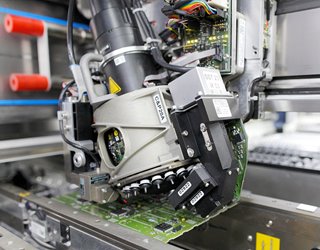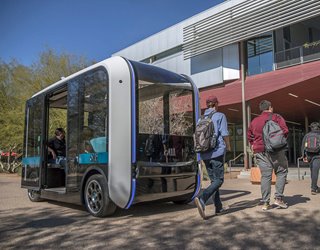7 Engineering Trends to Look Out For
7 Engineering Trends to Look Out For


From ubiquitous AI and plug-and-play Industry 4.0 to changing roles for engineers, the next decade will bring challenges and opportunities.
This story was updated on 10/21/2022.
Since its inception in 1951, Engineers Week has taken place every February to celebrate the groundbreaking impacts that engineers have made on society.
Instead of focusing on individual technologies—robots, additive manufacturing, Industry 4.0, and artificial intelligence—let’s look at seven engineering advancements to look out for in the coming years.
1. Autonomy Everywhere
Artificial intelligence is likely to define the decade. It has already begun to increase its footprint in engineering software, where generative design applications automatically optimize CAD designs to best fit the functional definition of a part, including how it will be manufactured.
Software vendors are also developing AI systems to advise engineers on materials selection and compliance. Meanwhile, robotic process automation (RPA) software enables bots to blast through clerical engineering chores such as auditing change orders, managing bills of materials, and searching for opportunities to standardize parts among multiple products.
AI shows up increasingly in autonomous systems including vehicles and drones, robots that route parts in factories and warehouses (and which may one day replace conveyor belts), and robots that deliver drugs and supplies in hospitals. AI makes possible a vast range of sophisticated products that respond autonomously to their environment or spoken commands.
Over the next decade, AI will get smarter, faster, and far more accurate. But first, it must overcome an imposing barrier: trust. It will take time to gain the public’s trust in a highway full of autonomous cars or a multimillion-dollar factory that makes its own decisions without human backup.
2. More and Better Big Data
While the term “big data” is becoming more mainstream, most applications still run on a relative trickle of data limited to a machine, a factory, or feedback from a fleet of products in the field.
That is changing rapidly, thanks to the growing proliferation of the internet of things (IoT) sensors that make it increasingly easier to collect real-time information. Add to those 5G wireless networks, which promise to not only boost data transmission speeds by factors of five to 100, but have much lower latency rates than existing 4G networks.
Further Reading: 7 Top Trends in Transportation Technology
Higher speeds and low latency can make it possible to do things in real time that are unthinkable now. For example, they could enable applications to track the loca
tion of autonomous vehicles and control their speed and location to optimize citywide traffic. Or, they could optimize the use of factory equipment and tasks over a wireless network.
They also make it possible to collect information from products in the field and compare them with digital twins. In factories, this would enable producers to monitor equipment to optimize output or forecast maintenance shutdowns. This lets engineers quantify the impact of their designs on lifespan in the future.
It is increasingly likely that over the next decade, engineers and marketers will increasingly differentiate their products by the smart use of data they collect.
3. Plug-and-Play World
Today, technologies like AI, IoT, big data, 5G, autonomous robots, and blockchain are stand-alone solutions. It is no small task to ensure a variety of IoT sensors can speak with a manufacturing execution system, which is in turn able to talk with a cloud-based data analytics package.
That leaves producers with two choices:
- Find a vendor who packages all these capabilities together—though this may lock them into a single and often expensive proprietary system.
- Mix and match best-of-class applications, paying programmers to integrate devices and software so data formats are compatible up and down the system.
This is going to change, and large engineering and manufacturing software companies are preparing accordingly. We are seeing a push towards greater standardization, increased interoperability, and faster deployments.
These changes will bring down costs for larger companies to create systems that span their entire enterprise—and make it possible for smaller firms with fewer resources to deploy the full range of Industry 4.0 technologies.
4. More Complex Products
People want more out of their products, and information technology delivers those capabilities. Automobiles are the best example of this trend, looking beyond consumer features—voice-controlled phones and music systems or internet hubs—and considering safety systems.
Today’s cars routinely take over braking when a car starts to skid or comes too close to the vehicle in front of it. They warn drivers when they stray from their lane, or when another vehicle is in their blind spot. Some feature fully autonomous highway driving, while others can park themselves. If they think a crash is likely, they may even tighten seat belts and readjust seat position.
Further Reading: Top 10 Bioengineering Trends for 2020
This trend will spread to other products—robots, manufacturing equipment, design software, consumer products, and more—as we create systems to translate human intent into action. Such intuitively obvious systems will seem simple to users, but present steep challenges for engineers. Those who build them must ensure they are safe for all use cases, and then find ways to test these increasingly complex products.
5. Old Industries Are New Again
“Disruption” may be an overused term, but information technology gives engineers a way to make once-staid products new again.
Take, for example, automotive technology. Years ago, who would have imagined that an upstart company like Tesla would be selling upwards of 100,000 cars per quarter and have a stock valuation higher than Toyota, Daimler, or GM? Or that fast-moving private companies like Space X, Blue Origin, and Relativity Space would challenge established giants like Lockheed, Orbital, and Arianespace in launch vehicles?
In many cases, these new companies have combined new business models with new technologies, such as batteries powerful enough to power a vehicle and 3D printing to radically reduce part count in rockets.
There are reasons to believe this trend is just getting started. Take, for example, autonomous robots.
Today, startups can begin with a shopping cart full of off-the-shelf sensors and mechanical parts. All they need to do is add a drop-in AI robot operating system (ROS), sensing, and mapping software, and they are ready to begin development. This explains why there are now literally hundreds of companies launching autonomous robots for niche applications ranging from heat exchanger cleaning to hospital drug dispensing.
Keep an eye out for even more disruption and opportunities in other fields as AI gets cheaper and more standardized.
6. Resilient Systems
Complexity is inherently unstable—which makes sense because the more degrees of freedom in a system, the greater the chance that something will go wrong. This applies equally to global supply chains, factory complexes, telecommunications systems, and the electrical grid, which is growing even more complicated as it stretches to accommodate such intermittent sources of green power as solar and wind.
Two factors compound these inherent instabilities. The first is a changing climate that makes severe weather events more likely. This puts infrastructure and all types of facilities at risk of flooding and wind damage. The second is the breakdown of the trade treaties and alliances that threatens global supply chains. As a result, engineers will increasingly have to incorporate the potential for disruption into their plans.
7. A Changing Profession
Engineers have traditionally been personally responsible for the projects they worked on. Today, as products have grown more complex, engineers increasingly work in multidisciplinary teams.
Further Reading: IoT 2020 Trends for Everyday Consumer Products
On any given project, a mechanical engineer might collaborate with:
- Electrical and electronic engineers to add embedded capabilities
- Manufacturing engineers to optimize design for production
- Purchasing and marketing team members to ensure the product meets cost, service, and functional goals
This is making design more democratic, but it may also erode an engineer’s sense of personal responsibility—which is something that the engineering profession will need to address in the coming years.
All this is taking place against a backdrop of post-recession companies still running very lean engineering teams. During the recession, companies reduced staff, and many moved engineering work to less costly nations overseas. That is not likely to reverse.
Instead, during the coming decade, corporations are likely to supplement their engineers with AI-driven software tools to seek greater productivity. While today’s engineers are increasingly pressed, younger engineers are also in a position to take big strides in responsibilities and salaries as the Baby Boomers retire.
Alan S. Brown is senior editor.
The latest engineering courses, now 25% off
As a leading developer of educational resources for engineers, ASME offers a wide range of courses designed to help engineers develop both theoretical knowledge and applicable skills.
With hundreds of relevant courses to choose from, ASME’s accredited, skill-based learning solutions support the success of your employees and your business.
For a limited time, get 25% off our on demand courses when you buy for a group of 5 or more. Use code 5FOR25 at checkout to train on:
When you’re ready to get started, you can browse our full course catalog here. And if you find that you have further questions about ASME’s learning options, don’t hesitate to get in touch.









